| Click on a picture to enlarge | The pictures you see after clicking on the small thumbnail
pictures, are shrunk to 5% of their original dimensions If you like to see a picture in full glory, send an email! |
| NEXT Story | PREVIOUS Story |
| For pictures click here | Back to Homepage | \
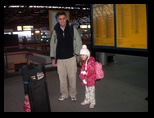 to Düsseldorf of two and a half hour. This airport took tremendous advantage from an increased number of Dutch passengers.
to Düsseldorf of two and a half hour. This airport took tremendous advantage from an increased number of Dutch passengers. 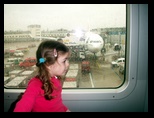 went smooth and we were well catered by the friendly cabin crew.
went smooth and we were well catered by the friendly cabin crew.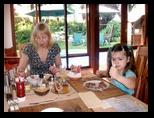 we hit the road, after some shopping. The prices appeared to be very reasonable.
Next destination was the Pilanesberg National Park. Why this? Well the main park is of course the Kruger park in the north. When Kruger called it a park, more than 100 years ago, it was easy as there was no agriculture and cattle for it was a malaria infested area, impossible to live here. It still is a malaria area and as no medication gives more than 90% protection, we decided to make a malaria free trip. Of course you do not wish to expose Mariska to any avoidable risk.
we hit the road, after some shopping. The prices appeared to be very reasonable.
Next destination was the Pilanesberg National Park. Why this? Well the main park is of course the Kruger park in the north. When Kruger called it a park, more than 100 years ago, it was easy as there was no agriculture and cattle for it was a malaria infested area, impossible to live here. It still is a malaria area and as no medication gives more than 90% protection, we decided to make a malaria free trip. Of course you do not wish to expose Mariska to any avoidable risk.
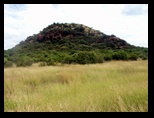 with many platinum mines, to the Bakgatla camp, in the north of the area. It is an ancient giant volcano, 27 kms in diameter, now rather flat at around one thousand meter high.
with many platinum mines, to the Bakgatla camp, in the north of the area. It is an ancient giant volcano, 27 kms in diameter, now rather flat at around one thousand meter high.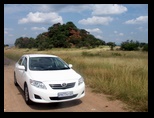 It is one of the biggest volcano’s worldwide and once must have dwarfed the Mount Everest.
It is one of the biggest volcano’s worldwide and once must have dwarfed the Mount Everest.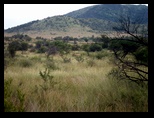
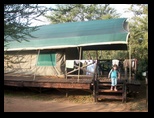 That gives you that “Livingstone-feeling”: rather primitive from the outside, baboon monkeys racing over the roof and everywhere the sounds of the jungle. So far the outside, inside we had power, a bathroom with hot & cold water and even a fridge. And the old petrol lamps were fitted with hi-tech incandescent bulbs. Anyhow, a very comfortable and romantic start of exploring African wildlife.
Upon arrival I booked an evening game safari. I expected that the ranger would take us directly to the spot where the big ones can be found. And indeed, in the first minutes we met enormous rhinoceroses
That gives you that “Livingstone-feeling”: rather primitive from the outside, baboon monkeys racing over the roof and everywhere the sounds of the jungle. So far the outside, inside we had power, a bathroom with hot & cold water and even a fridge. And the old petrol lamps were fitted with hi-tech incandescent bulbs. Anyhow, a very comfortable and romantic start of exploring African wildlife.
Upon arrival I booked an evening game safari. I expected that the ranger would take us directly to the spot where the big ones can be found. And indeed, in the first minutes we met enormous rhinoceroses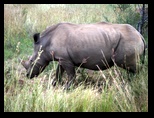 , while chewing grass they observed us very suspiciously
, while chewing grass they observed us very suspiciously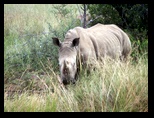 . They are the tanks of Nature, they have no enemies but can be very aggressive. They have gigantic spines on the nose
. They are the tanks of Nature, they have no enemies but can be very aggressive. They have gigantic spines on the nose 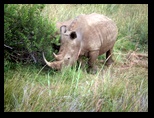 and know how to use them. So, this was nr ONE of the Big Five! Next we saw in a distance, lots of elegant impala’s.
Interesting.
and know how to use them. So, this was nr ONE of the Big Five! Next we saw in a distance, lots of elegant impala’s.
Interesting.
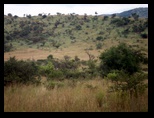 Then some zebra’s
Then some zebra’s 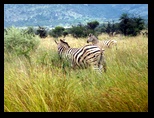 were showing off. A bunch of gnu’s
were showing off. A bunch of gnu’s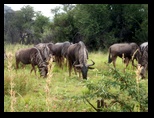 were next. That was unfortunately the end of the camera’s battery life. Further we saw kudu’s. An enormous male elephant was roaming down in a valley. Visibly he was on heat and searching for the girls. The guide quickly took a shortcut to meet him on his track. But he made a mistake and blocked the way of the giant and suddenly he was aggressive towards the truck. While the guide tried to escape, the bull with one giant tusk and another broken half one (that shows he did use them indeed), came very aggressive within 2 meters of us. Luckily the truck sides are protected with canvas, a good protection; at least against the rain.
Some guests were only taking pictures, others were just scared. That was Big One nr 2
were next. That was unfortunately the end of the camera’s battery life. Further we saw kudu’s. An enormous male elephant was roaming down in a valley. Visibly he was on heat and searching for the girls. The guide quickly took a shortcut to meet him on his track. But he made a mistake and blocked the way of the giant and suddenly he was aggressive towards the truck. While the guide tried to escape, the bull with one giant tusk and another broken half one (that shows he did use them indeed), came very aggressive within 2 meters of us. Luckily the truck sides are protected with canvas, a good protection; at least against the rain.
Some guests were only taking pictures, others were just scared. That was Big One nr 2
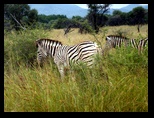 . Then we met a herd of gnoe’s
. Then we met a herd of gnoe’s and after that kudo’s as big as a horse
and after that kudo’s as big as a horse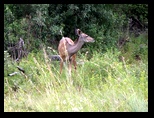 . Then we saw warthogs
. Then we saw warthogs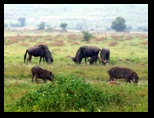 . Not too far from there, the girls were worried about two rhino’s
. Not too far from there, the girls were worried about two rhino’s . They have poor eyesight and attacks have been witnessed on trains and elephant carcasses. You better keep your car engine running!
. They have poor eyesight and attacks have been witnessed on trains and elephant carcasses. You better keep your car engine running!
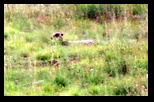 but his black ears can be seen on the picture. Occasionally he lifted his black tail. Officially it is not a Big 5, but we cheat the rare cheetah as a leopard, so Hurrah, nr 5.
but his black ears can be seen on the picture. Occasionally he lifted his black tail. Officially it is not a Big 5, but we cheat the rare cheetah as a leopard, so Hurrah, nr 5.
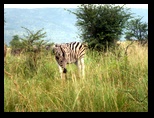 , which enjoyed to be photographed, we saw nests of weaver birds
, which enjoyed to be photographed, we saw nests of weaver birds 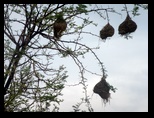 . A turtle
. A turtle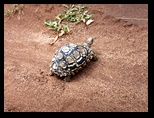 crosses our way at turtle speed. Then we saw a strange insect that at first sight had no wings but small black flaps. Only
crosses our way at turtle speed. Then we saw a strange insect that at first sight had no wings but small black flaps. Only 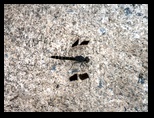 later, when we enlarged the picture we saw he has wings indeed, but fully transparent.
After more zebra’s
later, when we enlarged the picture we saw he has wings indeed, but fully transparent.
After more zebra’s 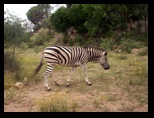 and fish eagles
and fish eagles 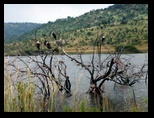 it was elephant time! A group females was having their lunch
it was elephant time! A group females was having their lunch 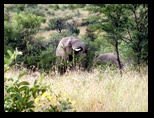 and we could watch the spectacle from a safe distance. Our luck was not over as the next herd was met soon. This time the herd was very close. Birgitt felt very uncomfortable when a giant angry mom of a baby made us clear that she did not liked that attention
and we could watch the spectacle from a safe distance. Our luck was not over as the next herd was met soon. This time the herd was very close. Birgitt felt very uncomfortable when a giant angry mom of a baby made us clear that she did not liked that attention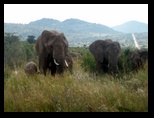 . So we quickly move to the other part of the herd where a juvenile was curiously watching us. Clearly visible is that the ears of the African elephant have the shape of that continent
. So we quickly move to the other part of the herd where a juvenile was curiously watching us. Clearly visible is that the ears of the African elephant have the shape of that continent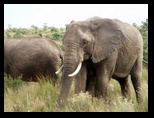 .
It was the end of the afternoon, time to quit, but then we met another big rhino
.
It was the end of the afternoon, time to quit, but then we met another big rhino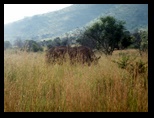 .
Mariska was exhausted and it was time for her to leave. But the gates were still not closed, so I decided to come back hopefully to catch the lion on picture, what was not successful the previous day due to a dead battery. But it is very unlikely here to see a lion, even less to see one two times. But the rangers have a service: SMS LIO to a number and you get the latest positions back. I went to that locations and many others were there, watching the area’s with binoculars. Only kudo's
.
Mariska was exhausted and it was time for her to leave. But the gates were still not closed, so I decided to come back hopefully to catch the lion on picture, what was not successful the previous day due to a dead battery. But it is very unlikely here to see a lion, even less to see one two times. But the rangers have a service: SMS LIO to a number and you get the latest positions back. I went to that locations and many others were there, watching the area’s with binoculars. Only kudo's 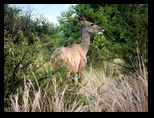 I thought about it. Why would a ranger or tour guide give away that position, while it is his job to show it to his paying guests? Most likely they send lion watchers to the wrong area. So I adopted an other strategy. I watched the safari tours scrambling to a complete different part of the territory and I followed one. And guess what? We arrived at concentration of 6 trucks with exiting people watching lions, at first invisible for me in the high grass. I was the only private car. The trucks were maneuvering to get the best view, very chaotic, I parked my car at the side and watched the spectacle, of course windows open to make pictures without glare. I decided to take my time, as they had discovered the animals and it was their business. I quietly prepared my camera looking inside the car and then suddenly my hart stood still: a giant lion head passed along my open window, less than a meter from my shoulder.
I thought about it. Why would a ranger or tour guide give away that position, while it is his job to show it to his paying guests? Most likely they send lion watchers to the wrong area. So I adopted an other strategy. I watched the safari tours scrambling to a complete different part of the territory and I followed one. And guess what? We arrived at concentration of 6 trucks with exiting people watching lions, at first invisible for me in the high grass. I was the only private car. The trucks were maneuvering to get the best view, very chaotic, I parked my car at the side and watched the spectacle, of course windows open to make pictures without glare. I decided to take my time, as they had discovered the animals and it was their business. I quietly prepared my camera looking inside the car and then suddenly my hart stood still: a giant lion head passed along my open window, less than a meter from my shoulder.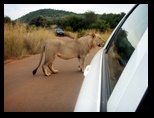 Luckily he had no interest in me and passed my car.
Luckily he had no interest in me and passed my car.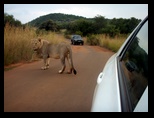 Quickly I took a few pictures. The lions were behaving like kings, no fear for humans or cars. And they produced an impressive roaring once in a while.
Quickly I took a few pictures. The lions were behaving like kings, no fear for humans or cars. And they produced an impressive roaring once in a while.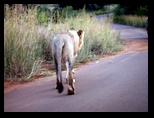 One of the tour guides ask me with a smile, but not friendly, -it was 20 minutes prior gate closure for tourists- how I would leave the National Park, and that was a sign to leave the lion area. But on my way out I had a few minutes left before the gate closed and I took a few minutes to check a lake if something special was to see there. And it was. A hippopotamus
One of the tour guides ask me with a smile, but not friendly, -it was 20 minutes prior gate closure for tourists- how I would leave the National Park, and that was a sign to leave the lion area. But on my way out I had a few minutes left before the gate closed and I took a few minutes to check a lake if something special was to see there. And it was. A hippopotamus 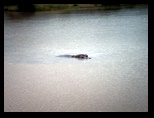 was loudly sniffing in the water, Opened his giant mouth
was loudly sniffing in the water, Opened his giant mouth 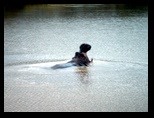 and even turned upside down showing his front legs!
and even turned upside down showing his front legs!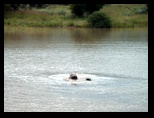 Hippos are considered very dangerous when they are out of the water. So all things are coming to an end and just before closing of the gates I left the park.
We were delighted that we saw so many interesting animals and it is good that they have a sanctuary here. But it is equally sad that those kings of the jungle, who lived here for million years on millions of square kilometers are now confined behind barbed wires in relatively small reserve. They lived in a very complex system of dependability and relations and did that, till the humans came here.
Their habitat was needed for agriculture nor mining. The colonists considered them as pest, as they were killing cattle and sheep. But I’m sure the real pest were the humans, destroying these invaluable nature recourses.
Next day, Saturday, we packed to leave for the south. It was raining and the trip went through area’s mostly inhabited by black people. Poverty is visible everywhere and clearly lots of time is still needed before they can have a life they deserve. But in the mean time it might be a good idea for them to clean up the mess they make.
At first the landscape had rocky outcrops, later it became flat or rolling agricultural landscape. Those areas’s used for agriculture looked well groomed but lots of land was dormant or neglected. Was this the Zimbabwe scenario? We passed along a shanty village and there something extraordinary could be seen. The top of many of the electricity poles was hanging on the cable, instead of supporting it. The villagers just had cut most of the poles middle part, most likely to use or burn it. Rather dangerous, as the cables were now close to the ground. How can you run an electricity company if people steal your poles?
It was raining often during the trip and that worked out nasty on the end. After a 7 hour drive we arrived at the Vaal River. Many activities could be joined, like rafting on the fast clear water of the river. After Parys we left the main road and had only 6 km to the Habula lodge, but that were the most challenging ones. The road ended in what was intended to be a gravel road, but many parts were mud road due to the recent heavy rains. Parts were even only suited for a fourwheel drive, or a good track for mud car racing, but somehow we managed to arrive at destination, be it that the white car was now a red car. Then came a surprise. At the end of the dirt road, the Habula lodge emerged, a complex of bungalows and a conference centre
Hippos are considered very dangerous when they are out of the water. So all things are coming to an end and just before closing of the gates I left the park.
We were delighted that we saw so many interesting animals and it is good that they have a sanctuary here. But it is equally sad that those kings of the jungle, who lived here for million years on millions of square kilometers are now confined behind barbed wires in relatively small reserve. They lived in a very complex system of dependability and relations and did that, till the humans came here.
Their habitat was needed for agriculture nor mining. The colonists considered them as pest, as they were killing cattle and sheep. But I’m sure the real pest were the humans, destroying these invaluable nature recourses.
Next day, Saturday, we packed to leave for the south. It was raining and the trip went through area’s mostly inhabited by black people. Poverty is visible everywhere and clearly lots of time is still needed before they can have a life they deserve. But in the mean time it might be a good idea for them to clean up the mess they make.
At first the landscape had rocky outcrops, later it became flat or rolling agricultural landscape. Those areas’s used for agriculture looked well groomed but lots of land was dormant or neglected. Was this the Zimbabwe scenario? We passed along a shanty village and there something extraordinary could be seen. The top of many of the electricity poles was hanging on the cable, instead of supporting it. The villagers just had cut most of the poles middle part, most likely to use or burn it. Rather dangerous, as the cables were now close to the ground. How can you run an electricity company if people steal your poles?
It was raining often during the trip and that worked out nasty on the end. After a 7 hour drive we arrived at the Vaal River. Many activities could be joined, like rafting on the fast clear water of the river. After Parys we left the main road and had only 6 km to the Habula lodge, but that were the most challenging ones. The road ended in what was intended to be a gravel road, but many parts were mud road due to the recent heavy rains. Parts were even only suited for a fourwheel drive, or a good track for mud car racing, but somehow we managed to arrive at destination, be it that the white car was now a red car. Then came a surprise. At the end of the dirt road, the Habula lodge emerged, a complex of bungalows and a conference centre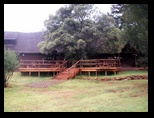 . All managed by a friendly lady with a friendly staff. Dinner was in a facility like an English country house and the 5 course buffet dinner was a delight. We were the only guests but the quantity was enough for a busload of guests. Our cabin was a luxurious two floor straw roofed house
. All managed by a friendly lady with a friendly staff. Dinner was in a facility like an English country house and the 5 course buffet dinner was a delight. We were the only guests but the quantity was enough for a busload of guests. Our cabin was a luxurious two floor straw roofed house 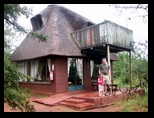 , very comfortable indeed and decorated with a classy taste and an eye for details.
, very comfortable indeed and decorated with a classy taste and an eye for details. 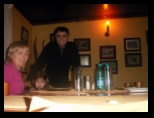 The breakfast
The breakfast 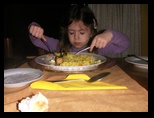 was world class as well.
was world class as well.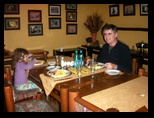 It must be not easy to operate a lodge to such a high standard in such a remote part of the world.
Before we left we heard about plans to asphalt the unsealed road in the autumn. That will be great for the many recreation business along the river Vaals.
The Habula lodge is located on the Vredefort Dome, a very interesting point on earth. Here was the most shocking event that ever happened on earth. It is the impact point of a giant celestial body, measuring 10 km in diameter and impacting with 200.000km/hr creating the biggest impact crater of the world. It made a hole of 40 km deep and the crater was 300km diameter, so till Johannesburg. The earth atmosphere must have been dark for years, by 70,000 cubic kilometers earth that were exploded in the air or evaporated and rained down on other places. The impact structure can easily be seen from the air, from maps and even from space. The dome in fact is the remains of the impact what was formed deep under the surface, as the top layer of 7 kms eventually eroded away. But further deep under the earth there may be interesting structures as well. The earthquake must have had a strength of 14 on the Richter scale and must have been violent all over the world. It happened 2023 million years ago. At that time there was only primitive life like algae and stromatolites (see our Australia 2006 story)
It is no coincidence that around the crater are the richest goldfield in the world, annually still producing half of the worlds gold production and even more of platinum.
As on earth the ancient impact craters are eroded away one can look to the moon to the impact craters there how it must have looked like in the past. The small impact point that appears, after the forces have been stabilized, as a mountain in the centre of the crater, is comparable with the dome, however eroded away. Now everywhere on the perimeter of the dome the vertical rocks
It must be not easy to operate a lodge to such a high standard in such a remote part of the world.
Before we left we heard about plans to asphalt the unsealed road in the autumn. That will be great for the many recreation business along the river Vaals.
The Habula lodge is located on the Vredefort Dome, a very interesting point on earth. Here was the most shocking event that ever happened on earth. It is the impact point of a giant celestial body, measuring 10 km in diameter and impacting with 200.000km/hr creating the biggest impact crater of the world. It made a hole of 40 km deep and the crater was 300km diameter, so till Johannesburg. The earth atmosphere must have been dark for years, by 70,000 cubic kilometers earth that were exploded in the air or evaporated and rained down on other places. The impact structure can easily be seen from the air, from maps and even from space. The dome in fact is the remains of the impact what was formed deep under the surface, as the top layer of 7 kms eventually eroded away. But further deep under the earth there may be interesting structures as well. The earthquake must have had a strength of 14 on the Richter scale and must have been violent all over the world. It happened 2023 million years ago. At that time there was only primitive life like algae and stromatolites (see our Australia 2006 story)
It is no coincidence that around the crater are the richest goldfield in the world, annually still producing half of the worlds gold production and even more of platinum.
As on earth the ancient impact craters are eroded away one can look to the moon to the impact craters there how it must have looked like in the past. The small impact point that appears, after the forces have been stabilized, as a mountain in the centre of the crater, is comparable with the dome, however eroded away. Now everywhere on the perimeter of the dome the vertical rocks 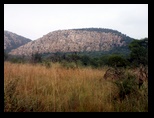 can be seen formed by the impact. They are very distinctive.
can be seen formed by the impact. They are very distinctive.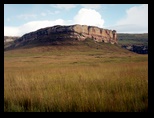 The geologist only 20 years ago agreed it was a giant meteorite that caused the strange geological formations, but after recognizing this, the facts supporting this scenario are abundant. The area is now an official World Heritage area.
Next day trip is a 5 hour drive to the Golden Gate national park on the border of the mountain state Lesotho .
The drive was through a mainly agricultural area. Most of the roads this trip were plagued by big potholes, each big enough to destroy the suspension system of a car. The problem is aggravated when the potholes are full of water, then he disappears under water and all you can do is avoiding every pool of water on the road. And that is not easy when it rains. We surely did not expect this from a developed country as South Africa. In the recent past we got the advice, if you like to go to South Africa, do it now before it deteriorates. Enroute we found a pool of water to clean the car, now we are cruising again in white Toyota.
The end of the trip approached and the mountains appeared.
The geologist only 20 years ago agreed it was a giant meteorite that caused the strange geological formations, but after recognizing this, the facts supporting this scenario are abundant. The area is now an official World Heritage area.
Next day trip is a 5 hour drive to the Golden Gate national park on the border of the mountain state Lesotho .
The drive was through a mainly agricultural area. Most of the roads this trip were plagued by big potholes, each big enough to destroy the suspension system of a car. The problem is aggravated when the potholes are full of water, then he disappears under water and all you can do is avoiding every pool of water on the road. And that is not easy when it rains. We surely did not expect this from a developed country as South Africa. In the recent past we got the advice, if you like to go to South Africa, do it now before it deteriorates. Enroute we found a pool of water to clean the car, now we are cruising again in white Toyota.
The end of the trip approached and the mountains appeared. 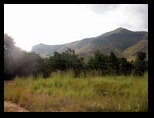 Nice yellow and orange sandstone mountains with green slopes were stunning.
Nice yellow and orange sandstone mountains with green slopes were stunning.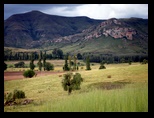 We crossed a pass of more than 2000m high. In the centre of the Golden Gate National Park we found the Glen Reenen Rest Camp, at not less than 1950 m altitude.
We crossed a pass of more than 2000m high. In the centre of the Golden Gate National Park we found the Glen Reenen Rest Camp, at not less than 1950 m altitude.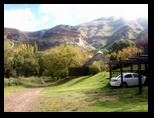 This was not to compare with our previous lodge. Ok, a roomy round hut and everything available, but all rather straight forward, however in a fascinating high alpine environment.
This was not to compare with our previous lodge. Ok, a roomy round hut and everything available, but all rather straight forward, however in a fascinating high alpine environment.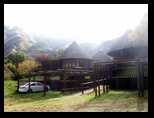 But unfortunately no meal or restaurant service was offered in this remote location. And nothing with us for self catering, even no sugar. And even no internet. But we are survivors and will survive this as well.
But next morning showed the benefits of this location. In minutes walking or driving we were in the mountain environment. We walked to a waterfall
But unfortunately no meal or restaurant service was offered in this remote location. And nothing with us for self catering, even no sugar. And even no internet. But we are survivors and will survive this as well.
But next morning showed the benefits of this location. In minutes walking or driving we were in the mountain environment. We walked to a waterfall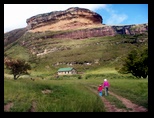 where beautiful flowers showed their brilliant colors.
where beautiful flowers showed their brilliant colors.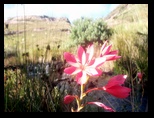 Then we left for a mountain trip.
Then we left for a mountain trip. 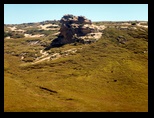 The area is known to have plants that do not grow elsewhere on earth. We hoped to see some special flowers. The area was high alpine terrain, with grass and plants, trees were absent. Impressive rock outcrops could be seen everywhere. First we saw the rather common ganzania,
The area is known to have plants that do not grow elsewhere on earth. We hoped to see some special flowers. The area was high alpine terrain, with grass and plants, trees were absent. Impressive rock outcrops could be seen everywhere. First we saw the rather common ganzania,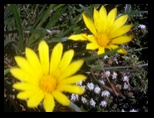 well known from Australia. Then we saw yellow flowering plants,
well known from Australia. Then we saw yellow flowering plants,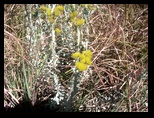 unknown to us. Then flowers that resembled oxalis deppei,
unknown to us. Then flowers that resembled oxalis deppei,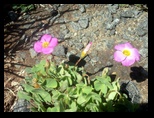 but were of course different. Close to these were yellow flowering plants
but were of course different. Close to these were yellow flowering plants 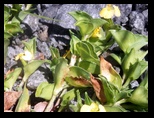 . Even a kind of mushroom
. Even a kind of mushroom 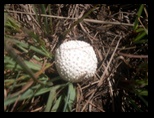 thrived here. Now really strange purple flowers
thrived here. Now really strange purple flowers 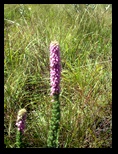 were discovered. The landscape was interesting: rolling green covered eroded sandstone mountains. Lots of tiny orchids
were discovered. The landscape was interesting: rolling green covered eroded sandstone mountains. Lots of tiny orchids 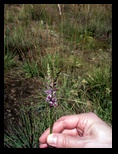 showed their flowers. We saw only one plant that resembled a still not flowering protea, the national flower of South Africa
showed their flowers. We saw only one plant that resembled a still not flowering protea, the national flower of South Africa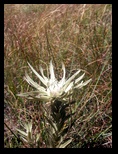 , be it that this was a small one. These strange abundantly flowering purple flowers
, be it that this was a small one. These strange abundantly flowering purple flowers 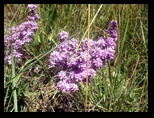 were generally found on one mountain slope.
Sometimes fault lines were clearly visible. This flower looks like a white gentian.
were generally found on one mountain slope.
Sometimes fault lines were clearly visible. This flower looks like a white gentian.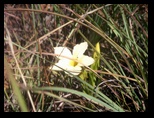 Anyone knows what this is?
Anyone knows what this is? 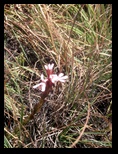 Some plants had berries.
Some plants had berries.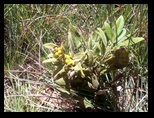 This succulent has very fine purple flowers,
This succulent has very fine purple flowers,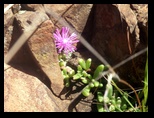 almost hidden between the rocks. Here another white flower.
almost hidden between the rocks. Here another white flower.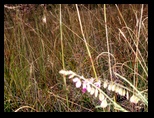 The yellow flowers look familiar
The yellow flowers look familiar 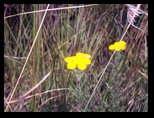 , the leaves of this plant not.
These incredible rich flowering purple plans has a secret: a strange “Bidsprinkhaan”,
, the leaves of this plant not.
These incredible rich flowering purple plans has a secret: a strange “Bidsprinkhaan”,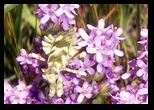 a predato trying to lure an insect. Though his colors are different, he hardly can be distinguished.
a predato trying to lure an insect. Though his colors are different, he hardly can be distinguished.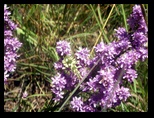 Moments later he catches an insect and is devouring it quietly.
Moments later he catches an insect and is devouring it quietly. 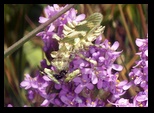 Here we see another yellow flower.
A white flower with Mariska on the background.
Then we see an incredibly nice flower: a succulent type plant with straw like flowers.
Here we see another yellow flower.
A white flower with Mariska on the background.
Then we see an incredibly nice flower: a succulent type plant with straw like flowers.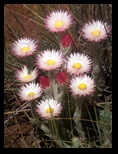 The view is magnificent
The view is magnificent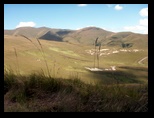 Here we see the last flowers of a Kniphofia.
Here we see the last flowers of a Kniphofia.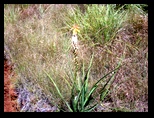 Good to see where it is originating.
Birgitt and Mariska enjoy the crisp clear mountain air.
Good to see where it is originating.
Birgitt and Mariska enjoy the crisp clear mountain air.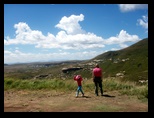 The view differs on every side of the mountain.
The green plant cover sometimes leave a bare piece of sandstone exposed, usually wet.
The view differs on every side of the mountain.
The green plant cover sometimes leave a bare piece of sandstone exposed, usually wet.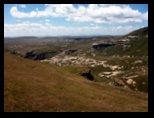 We do not see any animals here, but they must be here in big numbers, as the droppings show.
Again a strange flower.
Mariska discovers a strange bug
We do not see any animals here, but they must be here in big numbers, as the droppings show.
Again a strange flower.
Mariska discovers a strange bug 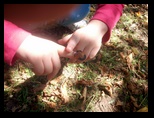 and the bug does not seem to bother Mariska’s attention. This bug did not bite her
and the bug does not seem to bother Mariska’s attention. This bug did not bite her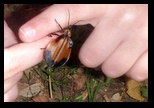 .
In the afternoon we discovered the northern part of the valley. In the background, behind the distinctive landmark,
.
In the afternoon we discovered the northern part of the valley. In the background, behind the distinctive landmark,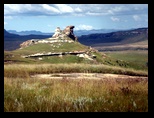 are the mountains of the independent kingdom of Lesotho.
In this area we saw few animals. Here, in the open, lots of monkey’s, probably baboons are running, the spots in the foreground
are the mountains of the independent kingdom of Lesotho.
In this area we saw few animals. Here, in the open, lots of monkey’s, probably baboons are running, the spots in the foreground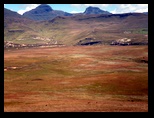 .
Wherever you look, you see interesting views. On this side many of the straw flowers. A part of the mountain was bright emerald green.
.
Wherever you look, you see interesting views. On this side many of the straw flowers. A part of the mountain was bright emerald green.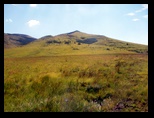 Nice view to Lesotho.
The next series is a panoramic view.
Nice view to Lesotho.
The next series is a panoramic view.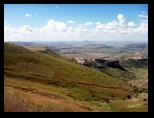
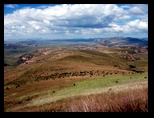

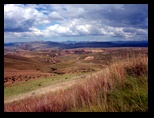 Mariska enjoys it a lot, just like her daddy.
Mariska enjoys it a lot, just like her daddy.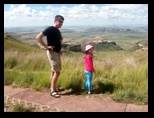 A nice grasshopper
A nice grasshopper 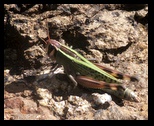 A rather strange soft rock formation, we gathered many crystals there.
A rather strange soft rock formation, we gathered many crystals there.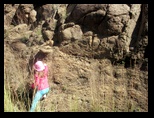 The steep road, background
The Drakensbergen
The steep road, background
The Drakensbergen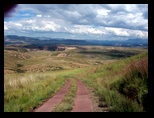
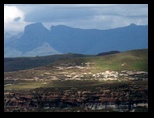
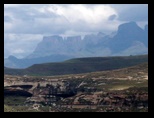
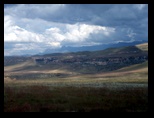 Close to our camp a massive rock, with an overhanging top
Close to our camp a massive rock, with an overhanging top 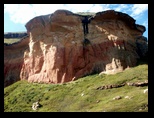 The sandstone has lots of colors
The sandstone has lots of colors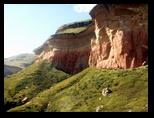 Picture from a cliff high over the river. Opposite the black rocks is the Glen Reenen Rest Camp
Picture from a cliff high over the river. Opposite the black rocks is the Glen Reenen Rest Camp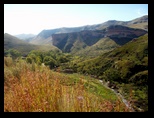 These are the black rocks from the previous picture
These are the black rocks from the previous picture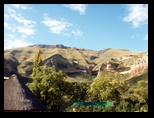 Our hut in the foreground,
Our hut in the foreground, 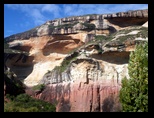 the rocks opposite the valley in the background.Mariska like to jump from this ramp
the rocks opposite the valley in the background.Mariska like to jump from this ramp 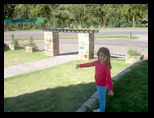 The golden gate National park is famous for its sunsets.
The golden gate National park is famous for its sunsets. 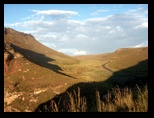 To check this out, we made a picture series of the sunset.
To check this out, we made a picture series of the sunset.
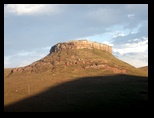
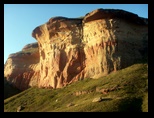
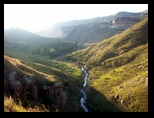
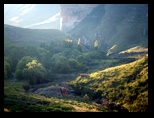
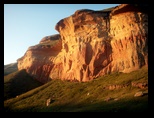
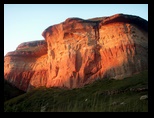
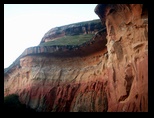
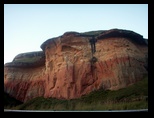 Time st sleep again
Time st sleep again 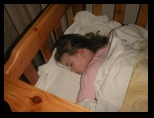 Next morning it was again time to pack and leave to the Drakensbergen. Sill a few pictures
Next morning it was again time to pack and leave to the Drakensbergen. Sill a few pictures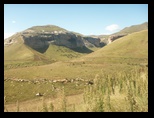 of the magnificent Golden Gate mountains
of the magnificent Golden Gate mountains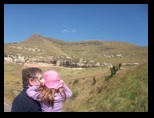 and slowly the trip was approaching the Drakensbergen. With tops close to 3500m a real high alpine area. We passed the Sterkfonteindam and saw
and slowly the trip was approaching the Drakensbergen. With tops close to 3500m a real high alpine area. We passed the Sterkfonteindam and saw 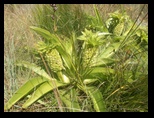 some interesting flowers there
some interesting flowers there 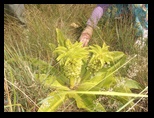 , really big. In the air we saw a few vultures dancing.
, really big. In the air we saw a few vultures dancing.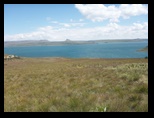 Further lots of baboons
Further lots of baboons 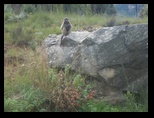 were on the road and the roadside.
We had booked two days at Ardmore guesthouse and the last 4 kilometers were again a dirt road. With the abundant rainfall in the last days it was again a mud paradise, but you get used to it.
But the surprise came when we approached the Ardmore Guesthouse, it was hosted by Paul and his wife, who had children as well and Mariska was directly friends with them. Al thinkable toys and children facilities were available
were on the road and the roadside.
We had booked two days at Ardmore guesthouse and the last 4 kilometers were again a dirt road. With the abundant rainfall in the last days it was again a mud paradise, but you get used to it.
But the surprise came when we approached the Ardmore Guesthouse, it was hosted by Paul and his wife, who had children as well and Mariska was directly friends with them. Al thinkable toys and children facilities were available
| Click on a picture to enlarge | The pictures you see after clicking on the small thumbnail
pictures, are shrunk to 5% of their original dimensions If you like to see a picture in full glory, send an email! |
| NEXT Story | PREVIOUS Story |
| For pictures click here | Back to Homepage | \